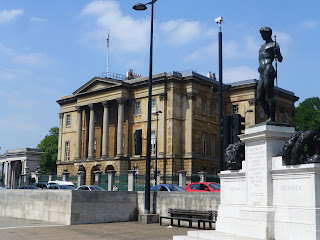So starting from the industrial looking Westminster station,
into Parliament Square.

But before heading into the first park, I wanted to go past Westminster Abbey,

into a building I knew of, but had never visited. And I bet you never even knew it existed. Its the Jewel Tower. No, not part of the Tower of London, but a lonely little remnant of the original Westminster Palace. Yes, it did once contain Royal treasures, but not for centuries. Later it was the storehouse for the House of Lords, and up until the 1930s was where our weights & measures office was based. But now it is owned by English Heritage.
So why am I so sure you will never have visited? Because there is so little to merit a visit. Trust me, if you go you will be disappointed. It has almost nothing within its 3 small floors. It is one of those awkward little places that clearly must be preserved for the nation, but are too small to really have much visitor appeal. As an English Heritage member it was free to me, but if I had paid my admittedly modest £3.50 entry fee, I would have felt cheated.
 |
| A collection of Imperial measures, bushels at the top. |
Anyway, back past the statue of George V
 |
| This grand but isolated house was almost demolished in the 1930s |
I went through the Abbey (closed to visitors for services, but allowing one to admire the stonework above the Japanese tourists)
One then returns to Parliament Square
 |
| Nelson Mandela |
 |
| Lord Palmerston |
 |
| And of course, Churchill |
and then through King Charles Street that separates the Treasury from the Foreign Office
 |
| Clive of India |
The park is home to a number of birds including a colony of Pelicans. Once a gift from the Russian Ambassador I don't think the current crop are their descendants, but they make a nice link to the time the Park was home to the King's exotic wildlife collection. This apparently included an elephant who was given a gallon of wine a day to drink. Modern ideas of animal welfare and nutrition have changed somewhat. I can't really think of an animal one would less want to get drunk.
Alongside the Park runs the Mall
And beyond the Mall are the three Royal Palaces: St James' Palace, originally built by King Henry VIII
and then next to each other Clarence House and Lancaster House.
Next to Buck House runs Green Park. By contrast this is probably the least pretty of London's main parks. Really just very plain, its main features just being its trees, especially the Broad Walk, an avenue of trees up the middle.
At the far end of Green Park one runs into a collection of War memorials. This is the most recent, a classical set of columns with a bronze group statue in honour of the airmen who did so much to save London, and indeed the country, in the last war.
More memorials are contained within the traffic Island, the central feature of which is Wellington Arch. This is well worth a visit - it has exhibition space at the top of the Arch, one room devoted to the bronze statues on top and the history of the Arch, the rest with a changing exhibition. Currently there is one based on John Betjeman and other early conservationists trying to preserve London, especially Georgian London.
 |
| A memorial to infantry in the First World War. Fine statue but hope the soldiers were better armed and protected than this figure suggests! |
On the other side of this roundabout is Apsley House,
and next to that the entrance to Hyde Park.

 |
| Henry Moore's "The Arches" |
Now one is in the fourth park, Kensington Gardens. It has several nice features including a statue of Peter Pan, but most picturesque are the Italian Fountains at the end.
Only a short further walk along one comes to another stretch of water, the Round Pond, which sits in front of Kensington Palace. Dividing the two, this weekend only, was an display by the Aston Martin owners club. Never going to see this many Astons together again!






























































































































































No comments:
Post a Comment